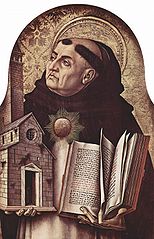Thomas Aquinas
During the 13th Century

The family of Thomas Aquinas was a noble one, his parents, the Count of Aquino and Countess of Teano, were related to Emperors Henry VI and Frederick II, as well as to the Kings of Aragon, Castile, and France. During his early education, Thomas exhibited great acumen in the medieval trivium of grammar, rhetoric, and logic. Because of his high birth, Thomas' entry into the Dominican order in the early 1240s was very surprising. His family employed various means to dissuade him from his vocation, including imprisoning him for two years.
After a stint as a student in Paris, Thomas made his way to Cologne to teach, receiving ordination to the priesthood in 1250. Soon after this, he was assigned to teach at Paris, where he also worked toward his degree of Doctor of Theology, which he received in 1257, with his friend St. Bonaventure, after some intramural political difficulty. The remainder of his life was spent in prayer, study, and writing his great Summa Theologica, a systematic attempt to present the findings of scholasticism. Although Thomas is sometimes perceived simply as an analytical and methodical writer, he was, especially in his later years, given to periods of mystical ecstasy. During one such experience, on December 6, 1273, he resigned from his writing project, indicating that he had perceived such wonders that his previous work seemed worthless.
The Summa Theologica was left unfinished, proceeding only as far as the ninetieth question of the third part. St. Thomas Aquinas died a few months later, on March 7, 1274. He was canonized in 1323 by John XXII. Although interest in Scholasticism in general and Thomism in particular waned during the seventeenth and eighteenth centuries, Leo XIII's encyclical Aeterni Patris in 1889 reestablished Thomism as the leading theological school of the Catholic church. Today, Thomist theology stands at the center of the Roman Catholic tradition.